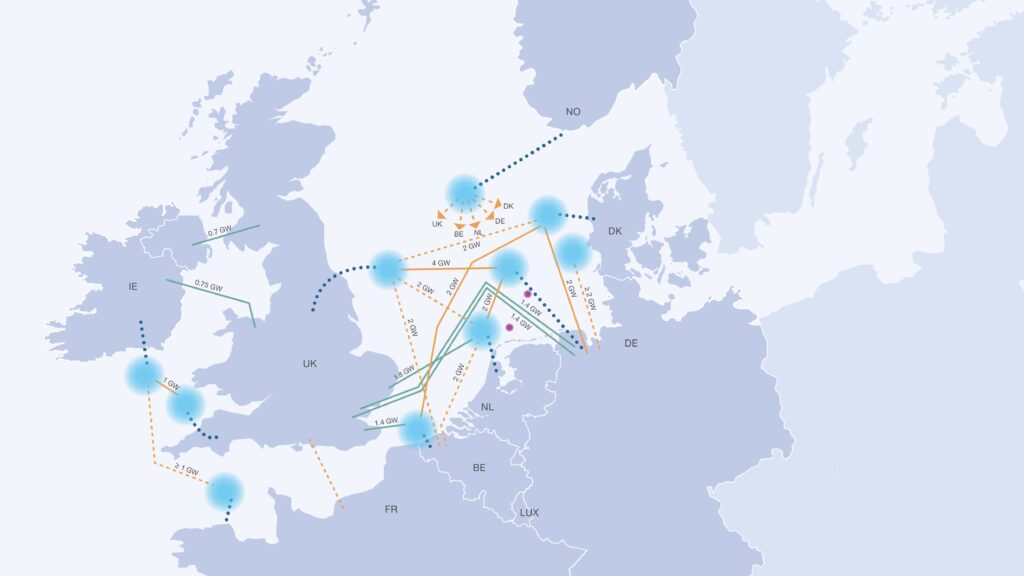The Offshore TSO Collaboration (OTC)—an initiative led by Transmission System Operators (TSOs) from Northern Europe—has unveiled a robust offshore infrastructure proposal set to redefine the region’s energy landscape by 2040. This comprehensive plan aims to accelerate Europe’s energy transition, bolster energy security, and establish long-term strategic autonomy through cross-border coordination.
“European energy independence must begin at sea,” stresses the OTC, which was launched in 2022 to align with the ambitions of the Esbjerg and Ostend Declarations. These political milestones called for unprecedented offshore cooperation to unlock the full potential of the North Sea, Irish Sea and Celtic Sea. Over the past three years, twelve TSOs have collaborated to advance infrastructure development aligned with this shared vision.
At WindEurope 2025 in Copenhagen, the OTC presented the findings of a pilot study which clearly demonstrate that a regional approach to offshore grid planning can offer substantial economic and environmental benefits. In contrast to project-by-project assessments, this integrated perspective maximises synergies and reduces duplication, enabling a more cost-efficient transition to renewable energy.

A Grid Map that supports system-level thinking
A major output of this collaboration is the OTC Grid Map 2025, a visual and strategic tool that categorises projects into three groups: planned, promising, and candidate projects. These initiatives are designed with a 2040 time horizon, allowing the TSOs to assess interactions and dependencies between different infrastructure elements.
“By evaluating projects collectively rather than in isolation, we can identify solutions that generate the greatest value for the region as a whole,” states the OTC. This includes the consideration of weather pattern diversity across the North Sea and how interconnection can smooth energy supply fluctuations.
The map outlines over 300 GW of offshore wind capacity expected across the region, including areas within national Exclusive Economic Zones (EEZs). It includes projects like Nautilus and LionLink, which connect offshore wind farms in Belgian and Dutch waters to Great Britain. Both projects have received initial regulatory backing and are expected to be operational around 2030.
New energy architecture: hybrid interconnectors, energy hubs and hydrogen integration
Moving beyond traditional radial connections, the proposed network integrates hybrid interconnectors, multi-purpose energy hubs, and hydrogen production and transport infrastructure. Among the flagship developments is Belgium’s Princess Elisabeth Island, which will act as an offshore node for up to 3.5 GW of wind capacity and serve as a connector to the UK and Denmark through the TritonLink and Nautilus interconnectors.
“Combining hybrid infrastructure and hydrogen systems enables a more efficient and flexible energy network,” the OTC notes. This model supports both electricity and hydrogen transmission, which is crucial for balancing seasonal demand and ensuring security of supply.
Germany’s Offshore Interconnection Cluster and Denmark’s Energy Island will play similar roles, offering modular connectivity for offshore and onshore systems. The Netherlands is also preparing large-scale energy hubs with capacities of up to 30 GW, complemented by a 500 MW offshore hydrogen demonstration project.
Structural challenges: cost-sharing, regulation and security
Despite the promising vision, the implementation of such a network faces structural hurdles. The OTC calls for a fit-for-purpose regulatory framework that includes mechanisms for cost-sharing among Member States, recognising the pan-European value of offshore projects.
“Hybrid interconnectors are a paradigm of shared benefits, requiring a fair and operational cost distribution model,” the OTC urges. This is in line with the updated TEN-E Regulation, which mandates the development of a new EU-wide guideline on cost-benefit analyses for sea-basin projects.
Additional challenges include regulatory support for anticipatory investments, particularly those needed for scalable offshore platforms, and security concerns linked to the geopolitical vulnerability of submarine infrastructure.
Towards a European energy system
The OTC plans to submit this new project set for inclusion in the Ten-Year Network Development Plan (TYNDP) 2026, setting the foundation for long-term investment and government negotiations. The group also proposes recurrent regional planning exercises, endorsed by governments and regulators, to maintain momentum and coordination.
“Offshore energy infrastructure is central to Europe’s energy future. With strong political commitment and cross-border cooperation, we can position Europe as a leader in offshore renewables,” the OTC affirmed in its 9 April statement.
As the EU progresses toward its 2050 net-zero objective, the North Sea emerges not only as a critical renewable resource but also as a blueprint for regional integration and resilience. With the right frameworks, this vision of a unified offshore grid can become Europe’s most powerful tool in securing sustainable and competitive energy for generations to come.






























